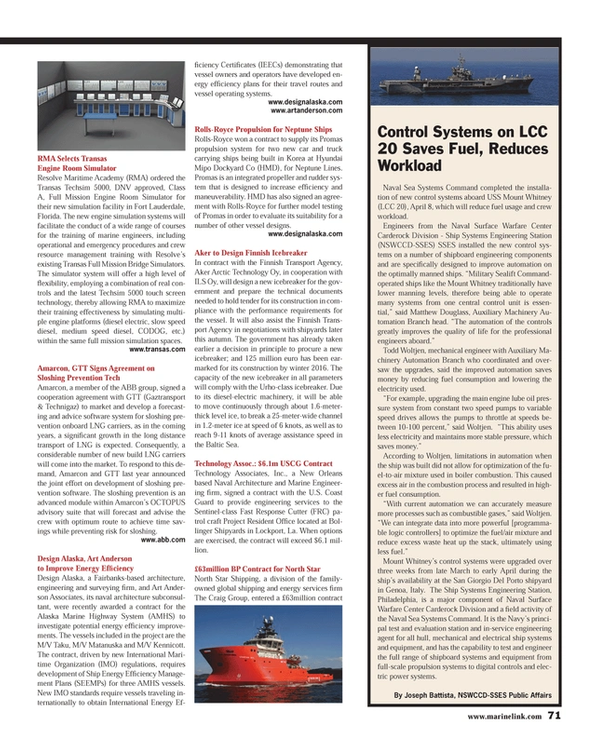
Control Systems on LCC 20 Saves Fuel, Reduces Workload
Naval Sea Systems Command completed the installation of new control systems aboard USS Mount Whitney (LCC 20), April 8, which will reduce fuel usage and crew workload.
Engineers from the Naval Surface Warfare Center Carderock Division - Ship Systems Engineering Station (NSWCCD-SSES) SSES installed the new control systems on a number of shipboard engineering components and are specifically designed to improve automation on the optimally manned ships. “Military Sealift Command-operated ships like the Mount Whitney traditionally have lower manning levels, therefore being able to operate many systems from one central control unit is essential,” said Matthew Douglass, Auxiliary Machinery Automation Branch head. “The automation of the controls greatly improves the quality of life for the professional engineers aboard.”
Todd Woltjen, mechanical engineer with Auxiliary Machinery Automation Branch who coordinated and oversaw the upgrades, said the improved automation saves money by reducing fuel consumption and lowering the electricity used.
“For example, upgrading the main engine lube oil pressure system from constant two speed pumps to variable speed drives allows the pumps to throttle at speeds between 10-100 percent,” said Woltjen. “This ability uses less electricity and maintains more stable pressure, which saves money.”
According to Woltjen, limitations in automation when the ship was built did not allow for optimization of the fuel-to-air mixture used in boiler combustion. This caused excess air in the combustion process and resulted in higher fuel consumption.
“With current automation we can accurately measure more processes such as combustible gases,” said Woltjen. “We can integrate data into more powerful [programmable logic controllers] to optimize the fuel/air mixture and reduce excess waste heat up the stack, ultimately using less fuel.”
Mount Whitney’s control systems were upgraded over three weeks from late March to early April during the ship’s availability at the San Giorgio Del Porto shipyard in Genoa, Italy. The Ship Systems Engineering Station, Philadelphia, is a major component of Naval Surface Warfare Center Carderock Division and a field activity of the Naval Sea Systems Command. It is the Navy’s principal test and evaluation station and in-service engineering agent for all hull, mechanical and electrical ship systems and equipment, and has the capability to test and engineer the full range of shipboard systems and equipment from full-scale propulsion systems to digital controls and electric power systems.
(As published in the May 2013 edition of Maritime Reporter & Engineering News - www.marinelink.com)
Read Control Systems on LCC 20 Saves Fuel, Reduces Workload in Pdf, Flash or Html5 edition of May 2013 Maritime Reporter
Other stories from May 2013 issue
Content
- New Scripps RV Honors Sally Ride page: 10
- Escort Tugs in San Francisco Bay page: 12
- Jumping Off the Fiscal Cliff? page: 14
- Rebuilding the Presumption of Preemption page: 18
- Get on Board with Shipyard Electrical Safety page: 20
- Crew System Integration on RHIBs and High Speed Craft page: 22
- BWT CASE STUDY: Hyde, PG & OSVs page: 30
- Bergen: A Unique Maritime Environment page: 32
- Unconventional Wisdom from Dolphin Geophysical CEO page: 36
- Grieg Star & DNV’s Crane Collaboration page: 38
- NES Powers Up in Competitive Market page: 39
- Atlantic Offshore and Ocean Response page: 39
- A Billion to One Shot page: 40
- Rolls-Royce has a Gas with Bergen Engines page: 41
- Açu Superport: A Modern Port Concept for Brazil page: 42
- Volvo Penta Targets Marine for Growth page: 46
- Realistic Engine Simulation page: 48
- In Big Ship Fuel Economy, Finances Trump Regulation page: 54
- Portable Oil Analysis Instruments page: 56
- Reusable Oil Filter Technology page: 58
- New Product: Parker's icountBSplus page: 59
- LNG Tech on tap at Europort 2013 page: 60
- Control Systems on LCC 20 Saves Fuel, Reduces Workload page: 71
- Titan Refloats Grounded Vessel page: 72


